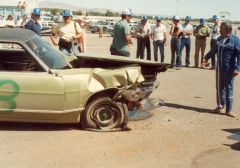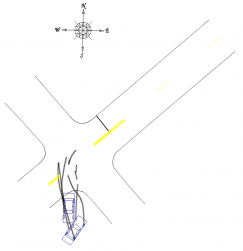
IAARS History
The International Association of Accident Reconstruction Specialists (IAARS) was started in New Brighton, Minnesota, USA in 1980. The IAARS is thought to be the first such organization of its type, and was started by a number of law enforcement personnel, also believed to be among the first trained in accident reconstruction. The IAARS now has members and associates from 38 states as well as Canada and Singapore.
The following photographs depict some of the earlier seminars and one of the earlier governing Boards and Officers.



Boise, Idaho – 1982
One of many tests conducted at the second annual seminar

Salt Lake City, Utah – 1984
Governing Board & Officers, left to right
Gary Phillips – Board Member
Tom Thompson – Board Member
Les Austin – Board Member
Gerry Murphy- Board Member
Roger Anhorn – Board Member
Mike Lofgren – President
Joe Fisk – Vice President
Not pictured
Travis Greenlee – Board Member
Wayne Rebischke – Board Member
Rod Lundgren – Secretary/Treasurer
1998 Boston Conference
Boston was the location for the 1998 Crash Conference. There were numerous presentations, including addressing topics of biomechanics of low speed impacts and low-speed insurance fraud, transfer and trace evidence, and dynamics and nomenclature of tires. There were staged collisions at that conference.
2001 IAARS Conference
Grand Rapids, Michigan, was the site of the 2001 Crash Conference. Topics presented included airbag systems, event data recorders, yaw rate sensors, heavy truck rollovers, and reliability of speed calculations based on crush.
As at other conferences, there were staged collisions. Of particular interest were automotive curb strikes which caused airbag deployments. At that time, there were some models of cars whose acceleration sensors were located such that a relatively minor front undercarriage strike would fire the airbag(s).
23rd IAARS Conference
In 2003, the IAARS conference was held in Olathe, Kansas. Some of the field testing included stopping demonstrations of tractor-trailers; the next three photos show some of those skid marks. There were four different sessions on the topic of mentoring reconstruction, and other crash-related topics were presented.



2008 Conference
Atlanta was the site for the 2008 IAARS conference. There were two presentations by Georgia State Troopers: one on the experiments conducted to verify the accuracy of spin analysis speed calculations presented by Trooper Holton and one on PIT maneuvers presented by Trooper Sturdivan. Other presentations were by Jeffrey Muttart on human factors and Bill Messerschmitt on heavy vehicle event data recorders, and there were other presenters.
DVDs of many IAARS Seminars are available. They can be purchased for $50 each. Some seminars include two or more discs. Contact the IAARS Secretary of you are interested in purchasing one or more discs.
2009 Boise Crash Conference
The 2009 IAARS Crash Conference was sponsored by the Idaho State Patrol and was located at the ISP training center just outside of Boise. This conference was held in September of 2009. There was one day of staged collisions, and there were many presentations relating to different factors associated with crash reconstruction.
For many years, there have been arguments related to the accuracy or application of drag-sled-derived coefficients of friction versus accelerometer data. Dr. Frank Navin is a Professor Emeritus of Civil Engineering at the University of British Columbia, and he has spent decades on roadway design and testing and crash-related investigations and research. He presented slides and data in support of his contention that properly derived drag-sled values were as valid as accelerometer data.
One of the staged collisions involved two Ford Crown Victorias, a 2000 model and a 2001 model. This staged collision was documented and reconstructed as if it had been an intersection collision on public streets. Reconstruction of this crash involved testing the drag factor with a drag sled and by accelerometer. Interestingly, three pulls of the drag sled provided friction values of 0.77, 0.75, and 0.74, while two tests using a Vericom Computer 2000 showed deceleration values of 0.77 and 0.76.



These three photographs show the final positions of the vehicles. The unbelted “driver” of the Ford which was struck in the left side was declared “dead” due to a severe closed-head injury to the left side of his head. Conservation of momentum was used to reconstruct this crash.
Each vehicle was weighed at the scene. The post-collision speed was calculated using fifty percent of full pavement drag factors, based on prior testing of the deceleration of rotating vehicles conducted at the ISP training center. Using these methods, the striking Ford was calculated to have been traveling at 24 mph while the other Ford was traveling at 23 mph when they collided. The diagram below shows the crash scene evidence.

There were five staged motorcycle collisions with a sedan. Photographs below show the aftermath of one.


2015 SCARS/IAARS Crash Conference, Charleston, SC, July 2015
At the 2015 Annual Crash Conference in Charleston, SC, there were some activities that were conducted outside the planned schedule. These included deceleration testing of a few off road vehicles and a documented ABS test skid with a 2007 Chevrolet Avalanche. Weather was clear and dry and hot— 90 to 100 degrees. These tests were conducted on level asphalt pavement in excellent condition. The fact that these off-road vehicles were tested on pavement should in no way be construed to suggest that it is ever safe to operate them on pavement, except for the golf cart.
Deceleration testing of the off-road vehicles was conducted by Andy Anderson, David Marthers, Bobby Mullinax, and Paul Roper. The procedure involved an operator accelerating the vehicle in question to a pre-arranged location at which brakes were applied. A radar gun was used to document the vehicle speed immediately before deceleration began, and the stopping distance was used to calculate deceleration. Each machine was tested several times, resulting in a range of rates of deceleration.

Lansing, Michigan – 1981
Attendees of first IAARS seminar
JOIN IAARS NOW!
Click here to learn more about joining IAARS or to manage your account.